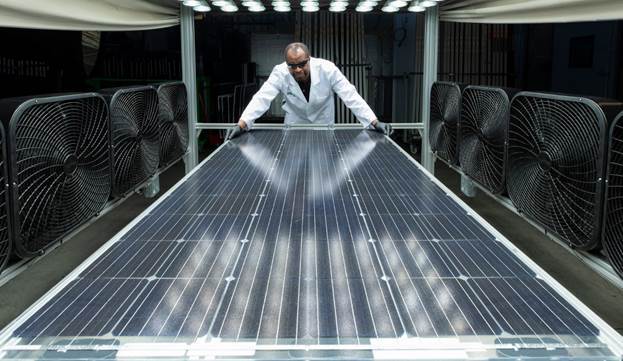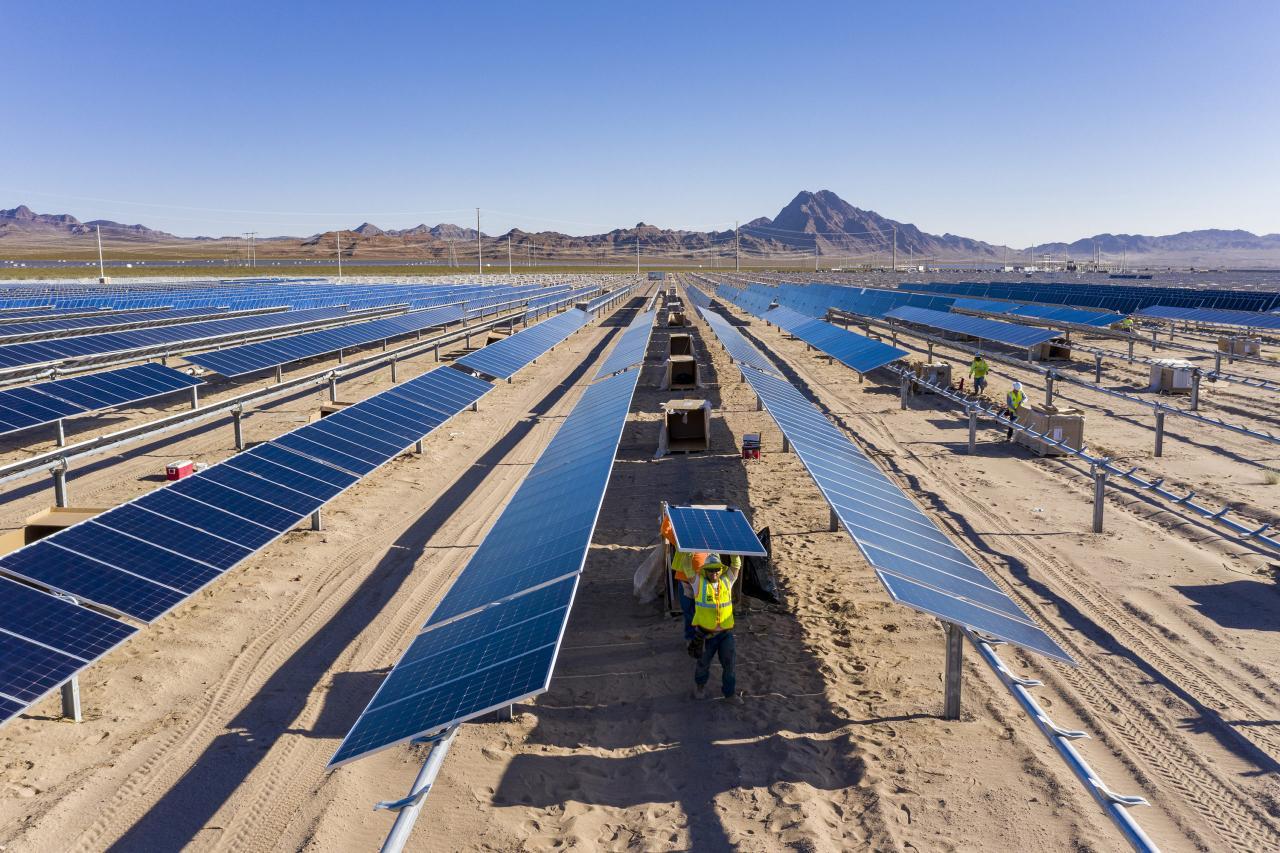
在PV实验室(PVEL)首席执行官Jenya Meydbray的基础上,在Nextracker基于白皮书“量化您的双面收益:使用校准的PVsyst模型输入参数”的博客系列中,讨论了影响双面光伏发电的几个关键因素。工厂优化。
设计和建造双面光伏电站并不比建造单面电站困难得多。然而,优化双面太阳能发电厂要复杂得多。双面能量获取对许多不影响单面植物的变量敏感,例如跟踪器的高宽比和模块下方的障碍物等。当然,反照率是唯一影响附加双面能量产量的最关键参数。这些因素解释了为什么跨站点的双面获取总是存在一些差异。
1.地面反射率:不断变化的反照率
反照率是无量纲的质量,它描述了表面反射光与原始入射辐照度的比率或百分比。在双面应用中考虑地面反射率的挑战的一部分是反照率不是一个单一的值。不仅反照率的大小根据一天或一年中的时间而变化,而且反照率的光谱也根据地面覆盖率而变化。对于草,岩石,雪,反照率的光谱是不同的。由于开发人员在自由场应用中人为增加反照率是不切实际的,因此相关的项目优化目标是准确表征特定于站点的平均或每月反照率值。
2.背面阴影:障碍物影响增益
跟踪器的设计和方向也对双面收益有重大影响。这些因素包括:
- 扭力管形状
- 扭矩管距模块背面的距离
- 立柱和轴承方向
- 追踪器高宽比
- 行间距
- 查看因素
位于模块和地面之间的障碍物将影响双面收益。这些障碍物可能包括系统平衡组件,例如线槽,PV线,汇流箱等。支撑结构本身也有助于背面遮蔽。与反照率不同,项目设计工程师可以通过战略性产品选择和设计决策来影响背面阴影。

内华达沙漠的Techren 2太阳能农场,配备NX Horizon追踪器和双面技术。图片来源:Swinerton可再生能源
3.组件不匹配:辐照度水平的相关性
在现场,光伏模块串串联连接,因此相同的电流流过每个模块。在1,500伏系统中,典型的是28个模块的串。不幸的是,对于每个PV模块,实现最大输出功率的最佳输出电流可能会略有不同。最佳输出电流的水平受多种因素影响,包括制造差异,性能下降和辐照度。单面或双面PV组件的不均匀降解可能是由电势诱导降解(PID),光和高温诱导降解(LeTID),密封剂泛黄和其他因素引起的。
对于双面PV组件技术,确定组件不匹配的相关辐照度是正面和背面辐照度的组合。在没有周围物体(例如树木或相邻模块行)的阴影的情况下,模块之间的正面照度通常是一致的。但是,模块背面的辐射受到模块背面和地面之间的障碍物的影响。最小化这些障碍将减少失配损失。
4.电气拉线:不匹配的潜在根源
在2P跟踪器设计中,穿线也是导致模块失配的潜在原因。具体而言,在上排中的模块与下排中的模块位于同一电串中是次优的。在这种情况下,模块背面的反射阳光强度会根据与地面的距离而在各行之间变化。这种辐照度不均匀会增加失配效应。类似地,基于不均匀的背面辐照度是垂直于还是平行于电池串和旁路二极管,纵向与横向方向可能会对失配产生影响。
5.产品资格:选择正确的组件
光伏组件的选择是开发太阳能项目中最动态和关键的方面之一。模块技术以多种方式迅速发展:
- 外形尺寸和额定功率正在增加。
- 许多制造商正在增加晶圆尺寸。其他人正在使用半切甚至第三切单元。
- 内部电路的接线方法不同。
- 双面模块可以具有玻璃-玻璃或玻璃-背板设计。
- 物料清单(BOM)的详细信息将根据制造商,工厂甚至批次而有所不同。
- 双面模块在正面和背面可能表现出不同的降解,这将随着时间的推移影响双面能量的获取。
为给定项目选择合适的产品将始终取决于特定地点的环境条件以及特定项目的融资要求。PVEL的产品资格认证计划(PQP)侧重于通过一系列可靠性和性能测试来评估PV模块,逆变器和储能系统的质量。开发人员和银行可以免费访问这些PVEL报告,以帮助选择供应商。
双面博客系列的第一篇文章“通过精确的建模和测量来捕获双面PV的全部价值的重要性”可以在此处找到。在下一个博客系列文章中,我们将介绍并比较在卓越太阳能中心,PVEL美国室外测试实验室和NREL双面测试平台上看到的真实测试结果。要下载整个“量化您的双面收益”白皮书, 请单击此处。
原文:
Albedo, Module Mismatch and More: Five Key Factors In Optimizing Your Bifacial PV Power Plants

In this installment of Nextracker’s blog series based on the white paper, “Quantifying Your Bifacial Gains: Using Calibrated PVsyst Model Input Parameters,” guest contributor Jenya Meydbray, CEO of PV Evolution Labs (PVEL), discusses several key factors that impact bifacial PV power plant optimization.
Designing and building a bifacial PV power plant is not much more difficult than building a monofacial power plant. Optimizing a bifacial solar plant, however, is far more complex. Bifacial energy gains are sensitive to many variables that do not impact monofacial plants, such as tracker height-to-width ratio and obstructions below the module, to name a few. Of course, albedo is the most critical parameter that uniquely impacts additional bifacial energy yields. These factors explain why there will always be some differences in bifacial gain across sites.
1. Ground Reflectance: The Ever-Changing Albedo
Albedo is a dimensionless quality that describes the ratio or percentage of surface-reflected light to the original incident irradiance. Part of the challenge of accounting for ground surface reflectivity in bifacial applications is that albedo is not a single value. Not only does the magnitude of the albedo change based on the time of day or year, but also the spectrum of the albedo changes based on the ground cover. The spectrum of the albedo is different for grass versus rocks versus snow. Since it is impractical for developers to artificially increase albedo in free-field applications, the relevant project optimization goal is to accurately characterize site-specific average or monthly albedo values.
2. Back-Side Shading: Obstructions Impact Gains
Tracker design and orientation also have a significant impact on bifacial gains. These factors include:
- Torque tube shape
- Torque tube distance from the back of the module
- Post and bearing orientation
- Tracker height-to-width ratio
- Row-to-row spacing
- View factor
Obstructions located between the modules and the ground will impact bifacial gains. These obstructions can include balance-of-system components, such as wire trays, PV wire, combiner boxes, and so forth. The support structure itself also contributes to back-side shading. Unlike albedo, project design engineers can influence back-side shading via strategic product selection and design decisions.

Techren 2 solar farm in the Nevada desert, featuring NX Horizon trackers paired with bifacial technology. Photo credit: Swinerton Renewable Energy
3. Module Mismatch: The Relevancy of Irradiance Levels
In the field, strings of PV modules are wired in series so the same electrical current passes through each module. In a 1,500-volt system, 28-module strings are typical. Unfortunately, the optimal output current to achieve maximum output power may be slightly different for each PV module. The level of the optimal output current is influenced by multiple factors including manufacturing variations, degradation, and irradiance. Nonuniform degradation of mono- or bifacial PV modules can be caused by potential-induced degradation (PID), light and elevated temperature induced degradation (LeTID), encapsulant yellowing, and other factors.
For bifacial PV module technology, the relevant irradiance level for determining module mismatch is the combination of front-side and back-side irradiance. In the absence of shading from nearby objects, such as trees or adjacent module rows, the front-side irradiance level is typically consistent across modules. However, the irradiance on the rear side of the module is impacted by obstructions between the back of the module and the ground. Minimizing these obstructions will reduce mismatch losses.
4. Electrical Stringing: Potential Source of Mismatch
In 2P-tracker designs, electrical stringing is also a potential source of module mismatch. Specifically, it is suboptimal to have modules from an upper row in the same electrical string as modules on a lower row. In this scenario, the intensity of the reflected sunlight on the back side of the modules varies between the rows based on distance to the ground. This irradiance non-uniformity will increase mismatch effects. Similarly, portrait versus landscape orientation could have an impact on mismatch based on whether the nonuniform back-side irradiance is perpendicular to or in parallel with the cell strings and bypass diodes.
5. Product Qualification: Selecting the Right Module
PV module selection is one of the most dynamic and critical aspects of developing a solar project. Module technology is evolving quickly in many ways:
- Form factors and power ratings are increasing.
- Many manufacturers are increasing wafer size; others are using half-cut or even third-cut cells.
- Internal circuit wiring methods differ.
- Bifacial modules may have glass-glass or glass-backsheet designs.
- Bill-of-material (BOM) details will vary, based on manufacturer, factory, or even batch.
- Bifacial modules can exhibit different degradation on the front and the back, which will impact bifacial energy gains over time.
Selecting the right product for a given project will always depend on site-specific environmental conditions as well as project-specific financing requirements. PVEL’s Product Qualification Programs (PQPs) are focused on evaluating the quality of PV modules, inverters, and energy-storage systems across a comprehensive set of reliability and performance tests. Developers and banks can access these PVEL reports at no cost to help with vendor selection.









